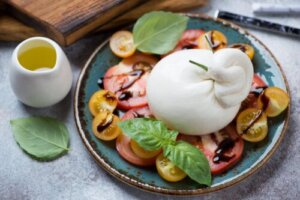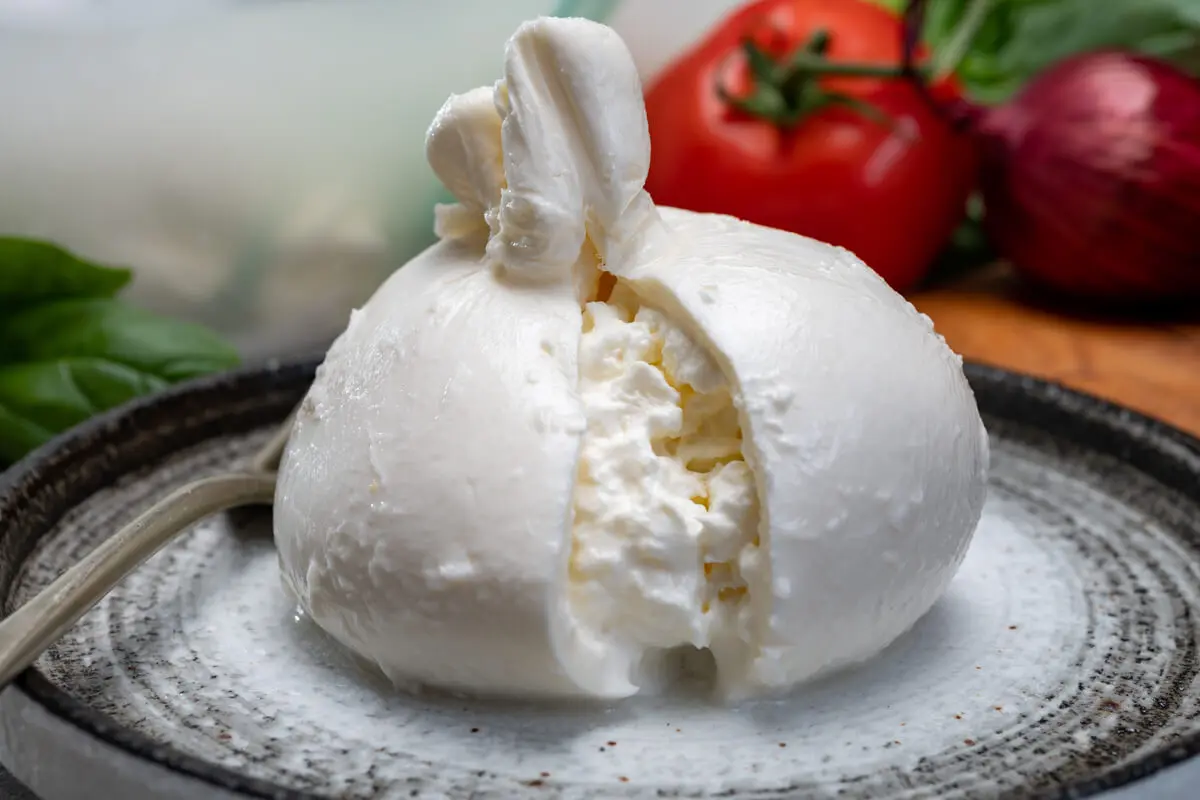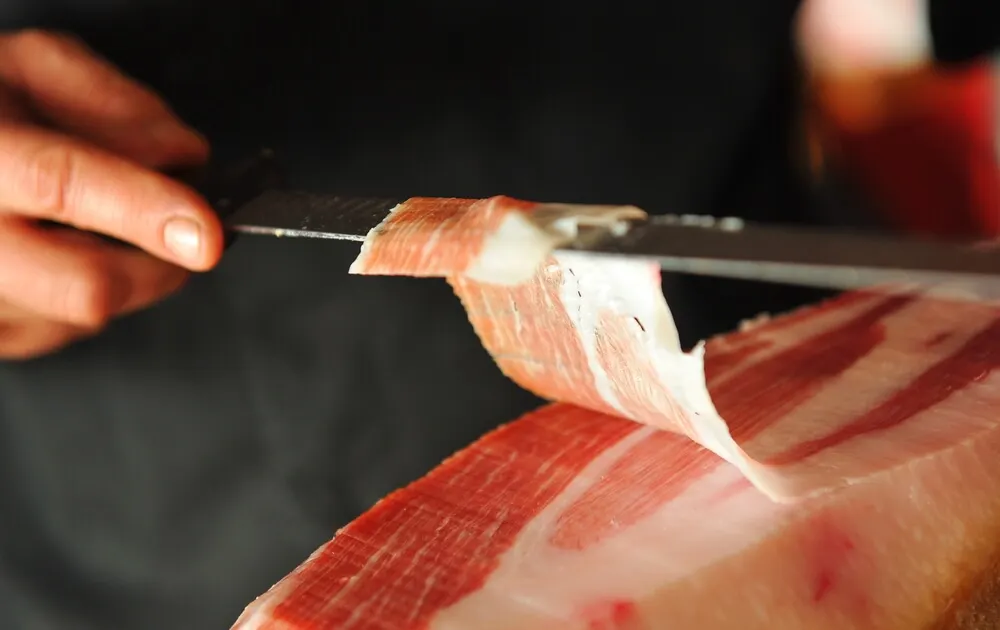Burrata: What Is It and What Are The Benefits?


Written and verified by the nutritionist Maria Patricia Pinero Corredor
Since burrata was first elaborated, many people have mistaken it for a type of fresh cheese. But the truth is that its manufacture has nothing to do with that of traditional cheese, since it’s a transformation of mozzarella cheese and its by-products into a gourmet category derivative.
This is a dairy product with a very particular history and is typical of southern Italy. The name derives from the Italian burro, which means ‘butter’, so you will have an idea of its sensory properties.
Have you ever tasted it? If you find this dairy derivative curious and want to know more about its preparation and benefits, stay with us.
What is burrata?
According to Salvadori del Prato’s book, burrata is a traditional product of the Apulia region of southern Italy. It’s similar to pasta filata cheeses and consists of a filling made of cream with strips of mozzarella cheese, often obtained from leftovers during its production.
According to del Prato, it’s likely that burrata was made to make use of leftover mozzarella cheese. However, another story tells that in 1956, the farmer Bianchino in the Apulia region, unable to deliver the cream and cream in time, decided to preserve them in sacks made from spun pasta.
In Italy, it’s a legal requirement to make mozzarella and burrata with buffalo milk. When made with cow’s milk it’s called flor di latte. According to Lo Russo, burrata is not included in the list of agricultural products of the European Union, but it’s included in the register of traditional food products of the Apulia region.
The characteristics of burrata
From a technical point of view, burrata has an external part made with mozzarella that is molded to form a hollow, open sphere. On the inside, there are strips of mozzarella with cream, which is called stracciatella.
The final product is spherical, with a head and a short neck which is tied with a knot. When cut, it spills out onto the plate.
It can weigh between 100 grams and 1 kilo. One article notes that burrata has a crustless surface, is milky white, smooth, and shiny.
Burrata can also be made with cow’s milk. The color is different, with a creamy yellow color highlighted by carotenoids. It can be considered an almost sweet mozzarella cheese, with a smooth texture and a thick cream that melts in the mouth.
A group of agronomists from the University of Foggia points out that its free water values for the growth of bacteria that alter the product are high. This is why it should be kept refrigerated and eaten quickly before it goes bad.
However, these experts managed to increase the shelf life of burrata from 3 to 10 days. They packed it in brine, added antimicrobials to the filling, and protected it with a coating.

We think you may be interested in reading this, too: Health Benefits and Nutritional Value of Mascarpone Cheese
How is it made?
Professor Atanu Jana from India explains that 2 techniques can be used: artisanal and industrial. It all starts with the production of mozzarella cheese. Sour whey is added to milk heated to 37 degrees Celsius. Calf rennet is also added.
The milk will curdle for 20 to 30 minutes before cutting. It’s kept under whey for another 30 minutes and kneaded with hot water at 85 to 90 degrees Celsius. It’s stretched to produce the threads and another part is molded to form the sack.
Each sack is then filled with the heavy cream mixture and the mozzarella threads. Close with a knot and finally place the burrata in a brine for 2 minutes to accentuate the flavor. Let it cool to 4 degrees Celsius and pack it in containers dipped in cold whey to prevent it from drying out.
Benefits of burrata
To talk about the benefits of burrata is to refer to the value of mozzarella cheese. Some may wonder how a cheese with 33% total fat can be beneficial. Well, there are other components that are favorable to health.
1. Burrata is a source of nutrients
Burrata is a source of essential amino acids, because, like other cheeses, the casein protein is concentrated. It contains 18 grams per 100 grams of burrata with a high biological value. The most abundant is the amino acid lysine.
Remember that to eat a traditional burrata you must control the portion you eat, no matter how delicious it is. Its saturated fat content is high, as is its cholesterol content. However, some experts have managed to produce low-fat burrata.
2. It’s a source of conjugated linoleic acid or CLA
The presence of conjugated linoleic acid may have certain health benefits. On average, cheese contains between 0.5 to 1.7 grams per 100 grams of total fatty acids. An article published in the International Journal of Dairy Technology points out the benefits of CLA.
This fatty acid has anti-thrombotic and anti-diabetic effects. Another study revealed that different lipids in the fat globule are associated with the reduction of chronic diseases typical of aging.
3. Bioactive peptides
In the chapter Nutritional benefits of cheese they explain that although burrata is not a ripened cheese, during its digestion bioactive peptides could be produced that can have a positive impact on health. Some of them have antihypertensive, antithrombotic, and antimicrobial activity.
4. May act as a source of probiotics
Some experts have considered fresh cheeses as a good vehicle for probiotic bacteria. They are a source of lactose and other nutrients that allow the growth of health-promoting microorganisms, while avoiding harmful bacteria.
These types of probiotic products improve oral health, the immune system, and gastrointestinal disorders and protect against respiratory diseases. Other benefits are recognized by several researchers.
Like this article? You may also like to read: Everything You Need to Know About Feta Cheese
How to consume burrata?
The contrast of texture on the outside and inside and its flavor, make that with burrata we can combine a great variety of dishes. In general, one of the best ways is with a little salt flakes, extra virgin olive oil to taste, and pepper.
Other good combinations are shown below:
- With ham, arugula, balsamic vinegar, and hard-boiled eggs.
- Using it with fresh figs, arugula, roasted pistachios, and balsamic vinegar.
- Fresh or roasted tomatoes mixed with vinegar and extra virgin olive oil.
- Place several grilled vegetables, such as eggplant, asparagus, zucchini, and peppers. Add olive oil and vinegar.
- With grated basil leaves, fresh tomato, and a drizzle of extra virgin olive oil.
- Sautéed nectarines or peaches, with toasted almonds or walnuts, arugula, and olive oil.
- It goes very well with artichoke, roasted endives, black olives, olive oil, and balsamic vinegar.

Simple recipe with burrata
We suggest a simple recipe to prepare without many ingredients. Remember that you can use it as a protein dish.
The ingredients are as follows:
- 1 burrata ball
- Salt and pepper
- Fresh basil
- Toasted sesame seeds
- A bell pepper
- 125 milliliters of cream
You prepare it following these steps:
- Heat a pan over low heat.
- Place the burrata together with the cream.
- Leave on the fire until the burrata disintegrates completely.
- Once dissolved, add salt and pepper to taste.
- When serving, hot or cold, add the sesame seeds, bell pepper, and basil leaves.
Remember that no matter how appetizing the burrata is, nothing in excess is good. Serve the normal portion and always accompany it with fresh or grilled vegetables. In this way, you maintain the caloric and nutritional balance of all the preparations.
All cited sources were thoroughly reviewed by our team to ensure their quality, reliability, currency, and validity. The bibliography of this article was considered reliable and of academic or scientific accuracy.
- Abd El-Salam, M. H., & El-Shibiny, S. (2014). Conjugated linoleic acid and vaccenic acid contents in cheeses: An overview from the literature. Journal of Food Composition and Analysis, 33(1), 117-126. https://www.sciencedirect.com/science/article/abs/pii/S0889157512001494?via%3Dihub
- Atanu, J. (2020). Burrata cheese-mozzarella transformed. International Journal of Fermented Food, 9(1), 13-17. https://www.indianjournals.com/ijor.aspx?target=ijor:ijff&volume=9&issue=1&article=002
- Bergamo, P., Fedele, E., Iannibelli, L., & Marzillo, G. (2003). Fat-soluble vitamin contents and fatty acid composition in organic and conventional Italian dairy products. Food chemistry, 82(4), 625-631. https://www.sciencedirect.com/science/article/abs/pii/S0308814603000360?via%3Dihub
- Cicognini, F. M., Rossi, F., Sigolo, S., Gallo, A., & Prandini, A. (2014). Conjugated linoleic acid isomer (cis9, trans11 and trans10, cis12) content in cheeses from Italian large-scale retail trade. International Dairy Journal, 34(2), 180-183. https://www.sciencedirect.com/science/article/abs/pii/S0958694613002343?via%3Dihub
- Collomb, M., Schmid, A., Sieber, R., Wechsler, D., & Ryhänen, E. L. (2006). Conjugated linoleic acids in milk fat: Variation and physiological effects. International Dairy Journal, 16(11), 1347-1361. https://www.sciencedirect.com/science/article/abs/pii/S0958694606001440?via%3Dihub
- Conte, A., Brescia, I., & Del Nobile, M. A. (2011). Lysozyme/EDTA disodium salt and modified-atmosphere packaging to prolong the shelf life of burrata cheese. Journal of Dairy Science, 94(11), 5289-5297. https://www.sciencedirect.com/science/article/pii/S0022030211005558
- Costantino, G., Calasso, M., Minervini, F., & De Angelis, M. (2020). Use of exopolysaccharide-synthesizing lactic acid bacteria and fat replacers for manufacturing reduced-fat Burrata cheese: Microbiological aspects and sensory evaluation. Microorganisms, 8(10), 1618. https://www.mdpi.com/2076-2607/8/10/1618
- Costa, C., Lucera, A., Conte, A., Zambrini, A. V., & Del Nobile, M. A. (2017). Technological strategies to preserve burrata cheese quality. Coatings, 7(7), 97. https://www.mdpi.com/2079-6412/7/7/97
- Dambrosio, A., Quaglia, N. C., Saracino, M., Malcangi, M., Montagna, C., Quinto, M. & Normanno, G. (2013). Microbiological quality of burrata cheese produced in Puglia region: Southern Italy. Journal of Food Protection, 76(11), 1981-1984. https://www.sciencedirect.com/science/article/pii/S0362028X23054261
- Da Cruz, A. G., Buriti, F. C. A., de Souza, C. H. B., Faria, J. A. F., & Saad, S. M. I. (2009). Probiotic cheese: health benefits, technological and stability aspects. Trends in Food Science & Technology, 20(8), 344-354. https://www.sciencedirect.com/science/article/abs/pii/S0924224409001770
- Di Cerbo, A., Miraglia, D., Marino, L., Stocchi, R., Loschi, A. R., Fisichella, S., … & Rea, S. (2020). “Burrata di Andria” PGI Cheese: Physicochemical and Microbiological Features. Foods, 9(11), 1694. https://www.mdpi.com/2304-8158/9/11/1694
- Faccia, M., Trani, A., Loizzo, P., Gagliardi, R., La Gatta, B., & Di Luccia, A. (2014). Detection of αs1-I casein in mozzarella Fiordilatte: A possible tool to reveal the use of stored curd in cheesemaking. Food Control, 42, 101-108. https://www.sciencedirect.com/science/article/abs/pii/S0956713514000590?via%3Dihub
- Ganesan, P., Kwak, H., & Hong, Y. Nutritional Benefits in Cheese. In R. Foster. (Ed.). Cheese:types, Nutrition and Consumption (pp. 269-289). https://www.researchgate.net/publication/284479670_Nutritional_Benefits_in_Cheese
- Lo Russo, G. (2008). Burrata cuore di panna e mozzarella. Origine, 4, 32-6. https://www.yumpu.com/it/document/read/15379326/burrata-cuore-di-panna-e-mozzarella-linformatore-agrario
- Minervini, F., Conte, A., Del Nobile, M. A., Gobbetti, M., & De Angelis, M. (2017). Dietary fibers and protective lactobacilli drive burrata cheese microbiome. Applied and Environmental Microbiology, 83(21), 1-15. https://journals.asm.org/doi/full/10.1128/AEM.01494-17
- Natrella, G., Gambacorta, G., & Faccia, M. (2022). Use of dry ice as innovative technology to preserve the chemical and microbial characteristics of burrata cheese. Journal of Food Processing and Preservation, 46(10), 16908. https://ifst.onlinelibrary.wiley.com/doi/full/10.1111/jfpp.16908
- Natrella, G., Gambacorta, G., & Faccia, M. (2023). Application of Commercial Biopreservation Starter in Combination with MAP for Shelf-Life Extension of Burrata Cheese. Foods, 12(9), 1867. https://www.mdpi.com/2304-8158/12/9/1867
- Rea, S., Marino, L., Stocchi, R., Branciari, R., Loschi, A. R., Miraglia, D., & Ranucci, D. (2016). Differences in Chemical, Physical and Microbiological Characteristics of Italian Burrata Cheeses Made in Artisanal and Industrial Plants of Apulia Region. Italian Journal of Food Safety, 5(3), 5879. https://pubmed.ncbi.nlm.nih.gov/27853715/
- Santanatoglia, A., Nzekoue, F. K., Alesi, A., Ricciutelli, M., Sagratini, G., Suo, X., … & Caprioli, G. (2023). Development of Innovative Vitamin D Enrichment Designs for Two Typical Italian Fresh Cheeses: Burrata and Giuncata. Molecules, 28(3), 1049. https://www.ncbi.nlm.nih.gov/pmc/articles/PMC5090119/
- Trani, A., Gambacorta, G., Gomes, T. F., Loizzo, P., Cassone, A., & Faccia, M. (2016). Production and characterisation of reduced-fat and PUFA-enriched Burrata cheese. The Journal of Dairy Research, 83(2), 236–241. https://pubmed.ncbi.nlm.nih.gov/27210495/
This text is provided for informational purposes only and does not replace consultation with a professional. If in doubt, consult your specialist.








